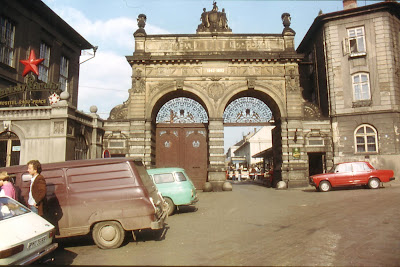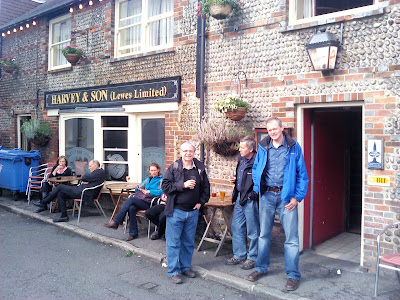In the first part of “The Grand Tour”, we looked at some of
the many breweries I have visited, here in the UK.
In this second part We take a look at some of the overseas breweries whose
doors have welcomed me.
Before going any further, it is worth noting that the
brewing process is the same the world over. There may be some variants,
particularly as many continental breweries employ a two or three stage mash
regime and fermentation times are typically longer; especially for lager-type
beers, but the basics still remain much as they do on these shores.
There were actually two of these, which followed each other in quick succession.
Both took place in the summer of 1975, when I was travelling around Europe,
by train with a friend from university.
We were travelling on an InterRail ticket, journeying in a
roughly circular route in a clockwise direction; a route which took in Amsterdam
and Copenhagen. Both cities are
home to world famous breweries, although today both companies have move out of
their inner city homes to green-field sites. Anyway, let’s get started.
The Dutch giant’s original home was right in the centre of Amsterdam,
and even 40 years ago was offering brewery tours on a daily basis. The tour
cost the princely sum of one Guilder; I haven’t got a clue what that equated to
back then, but it was token amount, and
anyway the money was donated to charity.
Unfortunately I remember very little from the tour, apart
from the brewery being an impressive brick-built brewery, which was just a
short walk from the city centre. The tour, which was conducted in English,
ended with at least one complementary beer and possibly two. The brewery closed
in 1988, when Heineken opened a much larger complex on the outskirts of Amsterdam.
Carlsberg’s original Copenhagen
home was a bus ride away from the city centre, in what appeared to be a
well-heeled leafy suburb. Like the Heineken tour it’s all rather blurred now,
but I do remember the enormous bottling hall, and the famous “Elephant Gate”,
with its ornate carvings. The photo below, shows a rather youthful me standing
at the gate.
First and only visit
behind the Iron Curtain
This trip involved a visit to Pilsner Urquell, in the
southern Bohemian city of Plzeň
(Pilsen). It took place in 1984, when Czechoslovakia,
as the country was then called, was firmly in the Eastern bloc, and controlled
by a totalitarian communist government. The trip organised by CAMRA Travel, a
short-lived subsidiary of the Campaign.
Our tour took place in the morning, when many of us were already suffering from the previous night’s over-indulgence, and I’m pretty sure we had glasses of beer plonked in front of us before the tour even commenced.
I remember the impressive brew-house with its polished
copper kettles, but the highlight was a trip underground to the labyrinth of
tunnels beneath the brewery. Here the beer slowly fermented in open wooden
vats, before being transferred into massive wooden casks, where it underwent a
period of extended maturation. The tunnels maintained an even temperature of
6ºC all year round.
 In 2012, I re-visited Pilsner Urquell, over a quarter of a
century later from that original tour. The brew-house looked much the same;
although it has been extended, but most
of the fermentation and maturation now takes place on a forest of massive,
vertical stainless steel tanks. We were again taken underground, as a small
number of the wooden vessels are still in use, for taste comparison purposes,
and we were even “treated” to a small sample of the unfiltered beer, straight
from one of the wooded casks.
In 2012, I re-visited Pilsner Urquell, over a quarter of a
century later from that original tour. The brew-house looked much the same;
although it has been extended, but most
of the fermentation and maturation now takes place on a forest of massive,
vertical stainless steel tanks. We were again taken underground, as a small
number of the wooden vessels are still in use, for taste comparison purposes,
and we were even “treated” to a small sample of the unfiltered beer, straight
from one of the wooded casks.
Largest overseas brewery:
This was a visit to the Guinness Brewery in Dublin,
whilst I was in the Irish capital for the 2014 European Beer Bloggers
Conference. We’d been invited to the brewery for a sneak preview of Guinness’s
brand spanking new No. 4 Brew-House which, at the time, was not fully
commissioned.
Guinness’s Dublin
site was not at all like I expected. It occupies some 64 acres, but it wasn’t
until we approached the maze of streets leading to the brewery that I realised
just how old parts of it are. On the way to the new brew-house we passed the No.3
Brew-House, constructed in the 1980's. This was still in operation, but was
due to be de-commissioned once the new plant came on-stream. With so much land
available to them, Guinness simply mothball one plant, before moving on to a
new one.
Despite us being sworn to secrecy and forbidden to take any
photos, there was precious little to see. I have to say new, hi-tech breweries
don’t do much for me; in fact they’re a huge turn-off. Give me a working
Victorian brewery any day, complete with levers and pulleys, plus various wheels
to turn, rather than a soul-less steel-framed shed, and I’m much more
interested. The new brew-house is extremely versatile and is capable of brewing
both ales and lagers, but that’s about all there is to say about it.
Rodenbach was a brewery I had desired to visit for many
years; having seen photos and read descriptions of the place in books by the
legendary Beer Hunter, Michael Jackson. Roger Protz also wrote about it. What
really inspired me were the photos of row after row of massive oak vats, all
containing beer which was quietly maturing away.
Rodenbach is a Flemish Red-Brown Beer. These beers
are a blend of young acidified, mature acidified and oak-matured beer, which
result from a lengthy maturation in oak casks. This lowers the pH of the
beer and gives it a longer shelf-life. The sour beer imparts a complex and
agreeably refreshing flavour, thus imparting this blended beer with a
distinctive edge, and making it the perfect aperitif.
My visit to the brewery in the town of Roeselare
was the final port of call on a whistle-stop tour of West
Flanders, which was part of the European Beer Bloggers post conference tour in 2015. Arriving in the
evening gave a very atmospheric feel to our visit, especially whilst walking
through the maturation rooms, filled with row after row of massive oak vats,
and it’s no exaggeration to say the tour more than exceeded my expectations.
The visit to Rodenbach leads nicely on to the next brewery which took place
the following day, in the picturesque city of Bruges.
After an overnight stay, in a rather swish hotel, we were treated to a trip round
De Halve Mann Brewery, which is right in the heart of Bruges. De
Halve Maan brews beers under the names of Brugse Zot and Straffe Hendrik, and
prior to our tour, we were able to try both beers over a very nice lunch.
We were first shown the new brew house, which has been
shoe-horned into the rather cramped city-centre site, and now occupies much of
the downstairs area. Of more interest was the old brewery, which is
constructed on a traditional tower principle.
The old equipment has been left in situ, and gives a
fascinating insight into days gone by. It is open to the public as a museum,
but we were given special access right to the very top of the tower, and out
into the open, from where we had an amazing view over the rooftops of Bruges.
Sumary
Sumary
I have undertaken several other tours around foreign
breweries, including two back in May, as part of the trip I made to Düsseldorf.
Our group visited Schumacher, which is one of the oldest and certainly one of
the most traditional Altbier breweries in Düsseldorf, and we also visited Brauerei Sünner; a Kölsch brewery in the neighbouring city of Cologne.
Two years previously, with the same group of people, I
visited two quite contrasting breweries in the Czech
Republic. The first was Bernard,
one of the country’s most respected breweries, who brew in the small town of Humpolec.
The second was Chotěboř Brewery in
the town of the same name.
Bernard is an old established brewery which has been given a
new lease of life, following significant investment; some of which came from
overseas. Chotěboř, on the other hand, is a brand new concern, but still
no less interesting. You can read more about these trips, here.
This just about sums ups the overseas breweries I have been privileged
to visit. They were all good and interesting in their own way proving, as I said
earlier, that the brewing process is much the same the world over.
All of these breweries are in Europe,
but next year I am planning a trip to the United
States, so possibly I may end up touring a
brewery or two over there.









































